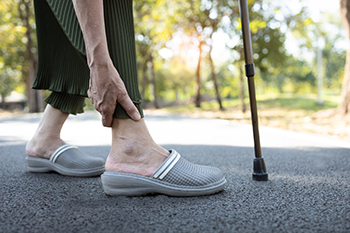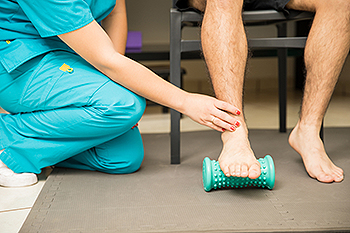
Each foot consists of 26 bones, as well as numerous ligaments, tendons, and muscles. As the aging process occurs, the feet can become weakened by daily stress, but there are measures that can be taken to maintain the health of the feet. These include washing and drying the feet thoroughly, especially between the toes, and trimming the toenails correctly, which may help to prevent ingrown toenails from developing. Blood circulation may be improved, which can contribute to having good foot health. This is accomplished by frequently practicing a gentle exercise routine. It is also beneficial to check the soles of the feet for existing cuts, bruises, and scrapes that may have developed, in addition to wearing socks that can absorb sweat. The feet can feel the most comfortable in shoes with a lower heel, made of breathable materials, and having adequate cushioning that may help to balance the weight of the body. If you have questions and would like more information about how to take care of elderly feet, please confer with a podiatrist.
Everyday foot care is very important to prevent infection and other foot ailments. If you need your feet checked, contact one of our podiatrists from Associates in Podiatry, PC. Our doctors can provide the care you need to keep you pain-free and on your feet.
Everyday Foot Care
Often, people take care of their bodies, face and hair more so than they do for their feet. But the feet are a very important aspect of our bodies, and one that we should pay more attention to. Without our feet, we would not be able to perform most daily tasks.
It is best to check your feet regularly to make sure there are no new bruises or cuts that you may not have noticed before. For dry feet, moisturizer can easily be a remedy and can be applied as often as necessary to the affected areas. Wearing shoes that fit well can also help you maintain good foot health, as well as making it easier to walk and do daily activities without the stress or pain of ill-fitting shoes, high heels, or even flip flops. Wearing clean socks with closed shoes is important to ensure that sweat and bacteria do not accumulate within the shoe. Clean socks help to prevent Athlete’s foot, fungi problems, bad odors, and can absorb sweat.
If you have any questions please feel free to contact our offices located in Pittsburgh-South Hills, and Pittsburgh-Bellevue, PA . We offer the newest diagnostic and treatment technologies for all your foot and ankle needs.




